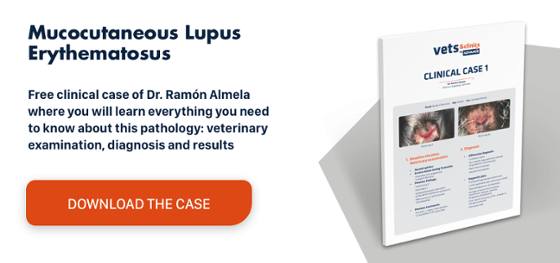Skin disorders in dogs: images and diagnosis
Flea allergy dermatitis (FAD)
FAD is the most common dermatological disease in dogs. In some dogs it develops after a prolonged flea infestation, whose saliva can trigger a hypersensitivity reaction. It is characterised by severe pruritus associated with papular rash, erythema and the formation of scabs and flakes in the lumbosacral region, base of the tail and hindlimbs. Many of the lesions are caused by scratching, including alopecia, pyotraumatic dermatitis and generalised superficial pyoderma. FAD is often associated with and complicated by secondary dermal infections such as bacterial folliculitis or Malassezia. The differential diagnosis includes atopic dermatitis, a food allergy or intolerance and parasitic diseases. The treatment is based on controlling the infestation with antiparasitic agents (imidacloprid, fipronil or lufenuron) and systemic corticotherapy (prednisone given orally at 1 mg/kg/24 h for 1 week). It can also be supplemented with antihistamines if the pruritus is poorly controlled (clemastine 0.05 mg/kg/12 h orally)1.
Pyoderma
Pyoderma is caused by a bacterial superinfection (usually by Staphylococcus intermedius) and is generally secondary to other infections (e.g., atopic dermatitis, parasitic diseases, neoplasms, demodicosis, etc.), so its recurrence will depend on the evolution of the underlying disease. It contributes significantly to canine morbidity because of the associated pruritus, pain and inflammatory changes in the skin.
Depending on the depth and nature of the infection, pyoderma may be superficial (epidermis) or deep (dermis and underlying adipose tissue), with the latter occurring much less frequently. The most relevant clinical sign is the appearance of papules or pustules on the skin, although scabs, xerosis and areas of alopecia may also be observed. Abscesses and cellulitis may also develop in deep pyoderma. A diagnosis based on the appearance and anatomical location of the lesions (whether generalised or localised to interdigital, acral or perianal regions, or the muzzle) means pyoderma is easily identified, yet the signs inherent to the bacterial infection lead to difficulties or diagnostic errors2.
The treatment of each case revolves around specific antibiotic therapy for the bacteria isolated in the dermal cultures, with adjuvant topical treatment based on regular antiseptic baths to help manage the lesions and prevent the appearance of multidrug-resistant bacteria (S. aureus, MRSA, etc.). The antibiotic therapy should be continued until up to 1 week after the clinical signs have disappeared in superficial pyoderma (about 3 weeks in total) and for more than 2 weeks in deep pyoderma (4–8 weeks) as patients may still be carriers of the pathogenic microorganism despite the disappearance of the lesions, which poses a consequent risk of transmission and recurrence3.
Sarcoptic mange
Sarcoptic mange is caused by the mite Sarcoptes scabiei, it is the most common type of mange in dogs and is highly contagious. It is characterised by very intense pruritus that can start anywhere on the body, but usually first appears on the ears, face, axillary region or ventral abdomen. It courses with papular/scabby lesions, erythema, excoriations and alopecia secondary to scratching. As it progresses the flaking intensifies at the margins of the ears, on the elbows and hocks. The differential diagnosis includes atopic dermatitis, dermatitis herpetiformis, psoriasis and insect bites. In case of infection, all other dogs that have been in contact with the patient (including asymptomatic dogs) should also be treated and the infected dog separated from other dogs and communal areas. The effect of the acaricide (ivermectin, selamectin, moxidectin or milbemycin oxime) becomes evident within 1–2 weeks after starting treatment4.
Atopic dermatitis
Atopic dogs have a dysfunctional skin barrier, so it is more susceptible to the penetration of environmental allergens (which trigger type I hypersensitivity reactions) and transdermal water loss (producing xerosis). It is mainly characterised by pruritus, which tends to aggravate the clinical picture until the disorder becomes chronic due to the skin lesions.
The concomitant onset of other opportunistic skin infections (such as otitis externa and atopic conjunctivitis and rhinitis) is common. Besides pruritus, other related signs are changes in the coat (saliva stains, dull hair), skin lesions and alopecia secondary to scratching, erythema and lichenification. Lesions are usually found in the ventral abdomen, axillary, flexural, interdigital and periorbital regions. The differential diagnosis includes FAD, adverse food reactions, sarcoptic mange, Staphylococci infection, contact dermatitis, insect bite dermatitis, cutaneous adverse drug reactions and Malassezia dermatitis.
Treatment is aimed at controlling the signs and secondary infections. Apoquel® and Cytopoint® are the latest drugs developed to treat atopic dermatitis: they are very safe, effective and have very few contraindications and side effects (while corticosteroids or cyclosporines can be used on an occasional basis to control outbreaks). Treatment should be completed with frequent baths and an appropriate diet to help restore and maintain the damaged skin.
The range of feeds for atopic dogs created by Affinity provides the nutrients and elements needed to enhance skin barrier integrity, reduce pruritus and control atopic flare-ups.
Malassezia dermatitis
Malassezia is a commensal yeast found in the ear canals, anal sacs, interdigital skin and mucocutaneous junctions. It becomes pathogenic when there is an imbalance between its reproductive mechanisms and those which limit its colonisation and proliferation. The condition is characterised by intense pruritus, erythema and greasy exudation with scaling and crusts (initial phase). Its chronic phase courses with greasy alopecia, lichenification and hyperpigmentation. Lesions develop on the ears, lips, muzzle, paws, ventral area of the neck and body, axillary, anal and perianal regions, and in the middle of limbs5.
Infected dogs emit a characteristic odour described as rancid and mouldy. The clinical picture may be aggravated by certain underlying diseases or staphylococcal pyoderma. The differential diagnosis includes atopy, FAD, superficial pyoderma and keratinisation defects6. It can be treated effectively with imidazoles, but in extensive or resistant cases the use of itraconazole (5 mg/kg/24 h) or ketoconazole (5–10 mg/kg twice a day for 20 days) is recommended together with two therapeutic baths weekly.
Topical treatment alone is effective in recent and more localised lesions. Shampoos can include 2–4% chlorhexidine, 2% miconazole, enilconazole, dichlorophen and keratolytic/keratoplastic agents.
REFERENCES:


